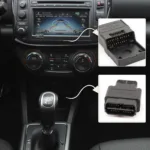OBD2 temperature gauges provide crucial insights into your vehicle’s engine health. From diagnosing overheating issues to optimizing performance, these tools are invaluable for both car enthusiasts and professional mechanics. This article explores everything you need to know about OBD2 temperature gauges, from their functionality and benefits to choosing the right one for your needs.
How OBD2 Temperature Gauges Work
OBD2 temperature gauges work by tapping into the wealth of data provided by your vehicle’s onboard diagnostic system. They connect to the OBD2 port, typically located under the dashboard, and communicate with the engine control unit (ECU). The ECU constantly monitors various engine parameters, including coolant temperature, and transmits this information to the OBD2 scanner. The gauge then interprets this data and displays it in a user-friendly format, often a digital readout or a graphical representation. This allows you to monitor the engine temperature in real-time and detect potential problems early. Want to know more about other OBD2 gauges? Check out our guide on ls obd2 gauges.
Benefits of Using OBD2 Temperature Gauges
Using an OBD2 temperature gauge offers several advantages over traditional dashboard gauges:
- Accuracy: OBD2 gauges offer precise temperature readings directly from the ECU, often more accurate than traditional gauges.
- Early Problem Detection: By monitoring real-time temperature data, you can identify potential overheating issues before they cause significant damage.
- Enhanced Diagnostics: OBD2 gauges provide more detailed temperature information, aiding in diagnosing complex engine problems.
- Performance Monitoring: Monitoring engine temperature can help optimize performance and fuel efficiency.
- Data Logging: Some advanced OBD2 scanners allow you to log temperature data over time, providing valuable insights into engine behavior. Looking for a powerful OBD2 app? Consider the obd2 fusion apk.
Choosing the Right OBD2 Temperature Gauge
Selecting the right OBD2 temperature gauge depends on your specific needs and budget. Here’s what to consider:
- Compatibility: Ensure the gauge is compatible with your vehicle’s make, model, and year.
- Display Type: Choose between digital readouts, graphical displays, or gauges with both options.
- Features: Consider additional features like data logging, customizable alerts, and compatibility with other OBD2 parameters.
- Budget: OBD2 temperature gauges range from affordable basic models to high-end professional tools.
Troubleshooting with OBD2 Temperature Gauges
OBD2 temperature gauges can be invaluable for troubleshooting engine problems. For example, if your engine is consistently running hot, the gauge can help pinpoint the cause, such as a faulty thermostat, a clogged radiator, or a low coolant level. By monitoring the temperature while testing different components, you can quickly isolate the issue. You can explore further troubleshooting techniques with das obd2.
Why is my OBD2 Showing High Temperature?
If your OBD2 scanner is showing a high temperature, don’t panic. It could be a simple issue like low coolant. However, it could also indicate a more serious problem such as a failing water pump or a head gasket leak. It’s essential to address the issue promptly to prevent engine damage.
What is a normal OBD2 temperature reading?
A normal OBD2 temperature reading typically falls between 195°F and 220°F (90°C and 104°C). However, this range can vary slightly depending on the vehicle and operating conditions. Consistently high or low readings outside this range warrant further investigation. Need help with specific vehicle applications? Check out resources like 2011 hyundai sante fe obd2 apps.
Conclusion
OBD2 temperature gauges are essential tools for maintaining and diagnosing your vehicle’s engine. By providing real-time temperature data, they allow for early problem detection, enhanced diagnostics, and performance monitoring. Investing in a quality OBD2 temperature gauge is a smart move for any car owner who wants to keep their engine running smoothly and avoid costly repairs.
FAQ
- Can I use an OBD2 temperature gauge on any car?
- What is the difference between coolant temperature and oil temperature?
- How do I install an OBD2 temperature gauge?
- What are the signs of a faulty OBD2 temperature gauge?
- Can I use an OBD2 temperature gauge with other diagnostic apps?
- What should I do if my OBD2 temperature gauge shows an extremely high reading?
- Where can I purchase a reliable OBD2 temperature gauge?
For further assistance, please contact us via WhatsApp: +1(641)206-8880, Email: [email protected] or visit us at 789 Elm Street, San Francisco, CA 94102, USA. Our customer support team is available 24/7.

